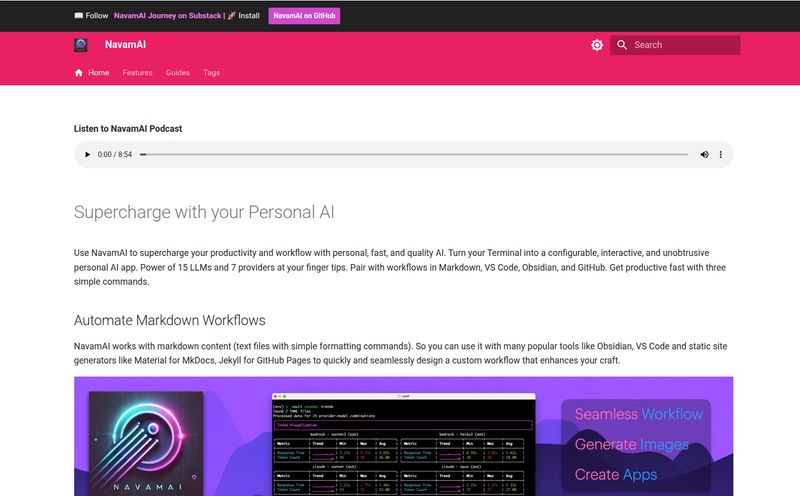I still get a cold sweat thinking about it. A few years back, a client handed me a gorgeous, multi-layered Photoshop design for a landing page. It had gradients, overlapping elements, and custom typography that made my designer heart sing but my developer brain scream. The next three days were a blur of slicing assets, measuring pixels, and wrestling with CSS positioning. It was tedious, soul-crushing work. We've all been there, right? Staring at a static image, knowing the mountain of code that stands between that picture and a functioning website.
For years, we've heard whispers of tools that could automate this. "Image to HTML" converters have been around, but frankly, most of them produced bloated, unusable code that was more trouble than it was worth. But AI is changing the game. And that’s what led me to IMG2HTML. It’s making some bold claims, and as someone who lives and breathes web development and traffic generation, I had to see if it was the real deal or just another gimmick.
So, What Exactly is IMG2HTML?
Let's get the basics out of the way. IMG2HTML is an AI tool that takes an image—a screenshot of a website, a Figma design, even a doodle on a napkin (okay, maybe not the napkin... yet)—and converts it into clean, responsive HTML and CSS code. It doesn't just stop there, though. It also supports modern frameworks like Tailwind CSS, React, Vue, and Angular. This part made my ears perk up. A tool that understands modern development stacks is a different beast entirely.
Think of it less like a blunt instrument and more like a skilled translator. It looks at the visual language of your design and interprets it into the syntactical language of the web. The promise is simple: dramatically cut down on the time you spend on front-end boilerplate and get straight to the fun stuff—making things work.
My First Impressions and a Quick Walkthrough
Signing up was straightforward. The interface is clean, almost minimalist. There’s no clutter, just a big friendly box inviting you to upload your image. So I did. I took a screenshot of a fairly complex hero section from a site I admire and dropped it in.

Visit IMG2HTML
What happens next is the little bit of magic you’re paying for. The AI chews on the image for a few moments, and then… code appears. On one side, you have your image. On the other, you have neatly formatted HTML and CSS. You can toggle between different frameworks, which is incredibly cool. Seeing my static image suddenly represented in React components or with Tailwind utility classes felt… significant. It was fast. Way faster than I could have coded it myself.
The Features That Actually Matter
A lot of AI tools are a mile wide and an inch deep. They have a laundry list of features that sound impressive but don’t hold up in a real workflow. I poked around IMG2HTML to see if it fell into that trap.
More Than Just a Simple Converter
Two features stood out beyond the basic conversion. The first is URL cloning. You can literally plug in a website's URL, and it will attempt to replicate the entire page. Ever seen a competitor's landing page and wanted to quickly build a wireframe based on its structure? This is your shortcut. It’s not about stealing, it’s about learning and rapid prototyping.
The second is component exporting. If you work in a component-based framework like React or Vue, you know the workflow. You build small, reusable pieces. IMG2HTML understands this, allowing you to export designs not as a monolithic block of code, but as individual components. This is a genuinely useful feature that shows they understand their audience.
The Framework Support is a Game-Changer
I have to come back to this because it's so important. Supporting vanilla HTML/CSS is one thing. But integrating Tailwind CSS is huge. Anyone who loves Tailwind knows its power, but also the initial pain of class-heavy markup. This tool generates that markup for you. For developers, this is a massive accelerator. The user reviews on their site echo this, with one Chief Developer specifically calling out the Tailwind support as a “real boon.” I have to agree.
Let's Talk About the Code Quality
This is the million-dollar question, isn't it? Does it produce code a professional would actually use? The answer is a slightly complicated, but mostly positive, yes.
The generated code is surprisingly clean. It uses semantic HTML tags (where it can identify them) and the CSS is well-structured. Is it perfect? No. And that's okay. I noticed one user review that said it “is not always perfect but it helps to make about 90% of the design.” I think that’s the most honest assessment you can get. This tool is not here to take your job. It’s here to do the most boring 90% of it for you.
"Think of it as a super-powered stencil. It gives you the outline, the structure, and all the tedious foundational work. You still have to come in with your fine-tipped pen to add the details, connect the logic, and make it truly your own."
You'll still need to tweak things, ensure perfect accessibility, and wire up any complex JavaScript. But it gets you from a blank screen to a fully-structured, styled page in minutes. That’s a win in my book.
The All-Important Question: What's the Cost?
IMG2HTML runs on a credit-based system. The main package highlighted is the Plus plan, which gives you 200 credits (or 200 images) for $29.99. There’s a yearly option that saves you 20%, which is standard stuff. They also offer a 3-day free trial so you can kick the tires before you commit.
Now, here's a point of friction for me: the website clearly states they do not offer refunds. This always makes me a little wary. It puts all the pressure on the user to be sure, so definitely make use of that free trial. The credit system means you're paying for what you use, which is fair. For a freelancer or a small agency, $30 to fast-track a few projects seems like a pretty good return on investment, especially when you calculate the hours saved.
Who is This Tool Really For?
After playing with it, I see a few clear winners:
- Developers: Use it for rapid prototyping, getting a project off the ground, or tackling the initial, tedious HTML/CSS structure of a complex design. It's a fantastic workflow accelerator.
- Marketing Teams & Founders: Have a design for a new landing page? You can get a functional prototype up and running for A/B testing or internal review without having to wait in the developer queue.
- Agencies: The time savings across multiple projects could be massive. It allows you to move from design approval to development faster, tightening your project timelines.
The Good, The Bad, and The AI
So, when the dust settles, what’s the verdict? No tool is without its flaws. Let's be real.
The good stuff is obvious: it’s fast, the code is surprisingly accurate, and the support for modern frameworks like Tailwind is a killer feature. It genuinely saves hours of grunt work.
On the not-so-good side, the credit-based system might not be for everyone, and the no-refunds policy is a bit of a bummer. You also have to manage your expectations. It will struggle with extremely complex, artistic, or poorly defined screenshots. It’s an assistant, not a magician.
Overall, though, the balance tips heavily in its favor. The little imperfections are a small price to pay for the sheer speed it introduces into the workflow.
Final Thoughts
IMG2HTML is a powerful and genuinely useful tool that delivers on its core promise. It's a prime example of how AI can augment, not replace, the skills of developers and creators. It won't build an entire application for you, but it will lay the foundation faster than you ever could by hand. It takes the most repetitive part of front-end development and just… handles it. For anyone who has ever lost a day of their life perfectly aligning divs, this feels like a long-overdue bit of relief. It’s definitely earned a spot in my digital toolbox.
Frequently Asked Questions about IMG2HTML
- Is the generated code mobile-friendly?
- Yes, the tool is designed to generate responsive code that should adapt to different screen sizes. However, you should always test it and you may need to make manual tweaks for perfect responsiveness on all devices.
- How does the credit system work?
- One credit allows you to process one image. The main plan gives you 200 credits for $29.99. Unused credits from a subscription typically roll over to the next month, which is a nice touch.
- Can I use it with any image?
- For best results, you should use clear, high-resolution screenshots of websites or digital designs (like from Figma or Sketch). Very blurry or highly artistic images may not convert accurately.
- Is there a free trial?
- Yes, IMG2HTML offers a 3-day free trial so you can test its capabilities and see if it fits your workflow before purchasing credits.
- Will this replace my need for a web developer?
- No. This tool is an assistant. It generates the front-end code (the visual part), but you'll still need a developer (or development skills) to handle backend logic, APIs, complex interactions, and to refine the code for production use.
Reference and Sources
- IMG2HTML Official Website
- IMG2HTML Pricing Page
- The Role Of AI In The Future Of Web Development - Forbes



